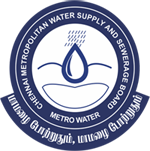



Chennai Metropolitan Water Supply and Sewerage Board
Water stored from the house roof top is presumed to be pure and potable as it will not flow on the ground and come into contact with any liquid or solid materials which can alter its quality. But, the rainwater falls on the roof, passes through the gutters and finally reaches the storage tank. In this process, water comes into contact with the dust, debris and leaf litter collected on the roof and the gutters. The water collected in the tank is stored for a period of 3 to 6 months before use. During this period, water will be in contact with tank walls and pipe fittings in the storage tank. If the stored water is exposed to outer environment it allows growth of algae and breeding of mosquitoes in the tank.
The reasons for variations in chemical constituents and bacteriological properties of water from Rooftop Rain Water Harvesting system (RRHS) could be many but the most important ones are listed below:
- Even though the water flows over the house roof for a short distance, it may dissolve some chemicals deposited on the roof from the atmosphere or the residue of chemical reaction between the atmospheric gases and the roof material.
- In general rainwater is pure and free from contamination. However, the air pollution from factories, industries, mining etc. does influence the chemical quality of water vapour in the atmosphere. When this water vapour condenses and comes in contact with the roof material, may react and leave residue on the roof. this phenomenon usually occurs over areas surrounding industries. The impact of this pollution on this rain water quality is not alarming, but needs attention.
- The rainwater while passing on the roof may carry the dust and debris resulting in change in the quality of water.
- The organic matter from the bird drops, rotten tree leaves, seeds and algae formation will be dissolved and carried by the rain water while flowing on the roof top. This may also cause quality changes of water stored in the tank.
- Breeding of mosquitoes or entry of insects through the opening of the tank such as over flow pipe may affect the quality of water.
The chemical and bacteriological contamination of roof water during the collection and storage processes can be prevented effectively by proper and regular maintenance of the system.
Analysis of Water samples
As the bacteriological contamination cannot be detected by the naked eye, it is necessary to analyse the quality of water in laboratories by collecting few water samples from storage tank. These tests help in verifying the presence of pathogenic bacteria. Following is the procedure for sample collection:
- Take three clean and dry sterilized glass or plastic bottles of 100 ml. size.
- Rinse the bottles in the tank water from which samples have to be collected.
- Fill the bottles with the tank water through the tap.
- Take the water samples for testing to the nearest laboratory within 48 hours of collection of samples.
- Observe the test reports for the presence of E-coli bacteria.
Presence of E-coli bacteria in the water samples is an indication of water contamination by pathogen bacteria, which tends to multiply. Therefore, treatment of water becomes necessary even if less number of E-coli is noticed.
Disinfecting water
Disinfecting is the process of killing the disease causing micro-organism present in the water. This can be done either by boiling the water in a vessel before consuming or by dissolving bleaching powder in required quantity to the water stored in the tank.
For disinfecting using bleaching powder, the general dosage recommended is 10 milligrams of bleaching powder containing 25% of free chlorine per litre of water. this meets the required standard of 2.5 milligrams of chlorine per litre of water.
After adding the bleaching powder, the water shall be stirred thoroughly for even distribution of the disinfectant agent. The water should be kept without use for about 30 minutes after adding bleaching powder. Following table can be referred for arriving at the quantity of bleaching powder to be added for different water depths in the storage tank.
Recommended dosage of bleaching powder for Disinfecting water
| Storage | Dosage of bleaching powder ( in grams ) | |||
| Capacity of Tank (litre) | Full tank | Tank three fourth (3/4) full | Tank half (1/2) full | Tank one fourth (1/4) full |
| 5,000 | 50 | 37.5 | 25 | 12.5 |
| 6,000 | 60 | 45.0 | 30 | 15.0 |
| 7,000 | 70 | 52.5 | 35 | 17.5 |
| 8,000 | 80 | 60.0 | 40 | 20.0 |
| 9,000 | 90 | 67.5 | 45 | 22.5 |
| 10,000 | 100 | 75.0 | 50 | 20.0 |